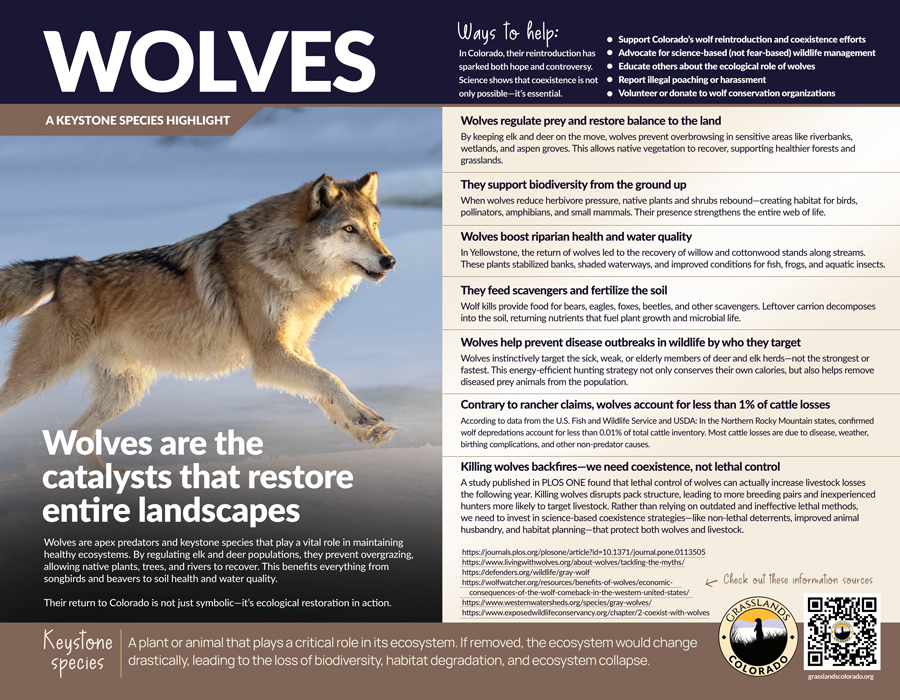
Wolves are the catalysts that restore entire landscapes
Wolves are apex predators and keystone species that play a vital role in maintaining healthy ecosystems. By regulating elk and deer populations, they prevent overgrazing, allowing native plants, trees, and rivers to recover. This benefits everything from songbirds and beavers to soil health and water quality. Their return to Colorado is not just symbolic—it’s ecological restoration in action.
Wolves regulate prey and restore balance to the land
By keeping elk and deer on the move, wolves prevent over browsing in sensitive areas like riverbanks, wetlands, and aspen groves. This allows native vegetation to recover, supporting healthier forests and grasslands.
They support biodiversity from the ground up
When wolves reduce herbivore pressure, native plants and shrubs rebound—creating habitat for birds, pollinators, amphibians, and small mammals. Their presence strengthens the entire web of life. Wolves boost riparian health and water quality In Yellowstone, the return of wolves led to the recovery of willow and cottonwood stands along streams. These plants stabilized banks, shaded waterways, and improved conditions for fish, frogs, and aquatic insects.
They feed scavengers and fertilize the soil
Wolf kills provide food for bears, eagles, foxes, beetles, and other scavengers. Leftover carrion decomposes into the soil, returning nutrients that fuel plant growth and microbial life.
Wolves help prevent disease outbreaks in wildlife by who they target
Wolves instinctively target the sick, weak, or elderly members of deer and elk herds—not the strongest or fastest. This energy-efficient hunting strategy not only conserves their own calories, but also helps remove diseased prey animals from the population.
Contrary to rancher claims, wolves account for less than 1% of cattle losses
According to data from the U.S. Fish and Wildlife Service and USDA: In the Northern Rocky Mountain states, confirmed wolf depredations account for less than 0.01% of total cattle inventory. Most cattle losses are due to disease, weather, birthing complications, and other non-predator causes.
Killing wolves backfires—we need coexistence, not lethal control
A study published in PLOS ONE (Link to: https://journals.plos.org/plosone/article?id=10.1371/journal.pone.0113505) found that lethal control of wolves can actually increase livestock losses the following year. Killing wolves disrupts pack structure, leading to more breeding pairs and inexperienced hunters more likely to target livestock. Rather than relying on outdated and ineffective lethal methods, we need to invest in science-based coexistence strategies—like non-lethal deterrents, improved animal husbandry, and habitat planning—that protect both wolves and livestock.
Ways to help:
In Colorado, their reintroduction has sparked both hope and controversy. Science shows that coexistence is not only possible—it’s essential.
- Support Colorado’s wolf reintroduction and coexistence efforts
- Advocate for science-based (not fear-based) wildlife management
- Educate others about the ecological role of wolves
- Report illegal poaching or harassment
- Volunteer or donate to wolf conservation organizations
Check out these information sources:
https://journals.plos.org/plosone/article?id=10.1371/journal.pone.0113505
https://www.livingwithwolves.org/about-wolves/tackling-the-myths/
https://defenders.org/wildlife/gray-wolf
https://www.westernwatersheds.org/species/gray-wolves/
https://www.exposedwildlifeconservancy.org/chapter/2-coexist-with-wolves
Keywords to use in Social posts:
#ColoradoWildlife #GrasslandsColorado #KeystoneSpecies #PredatorsMatter #EcosystemGuardians #PredatorsForBalance #HabitatConnectivity #ProtectWildCorridors #RewildColorado #RewildtheWest #Biodiversity #NativeHabitat #LivingWithWolves #CoexistInColorado #ScienceNotFear #FrontRangeWildlife